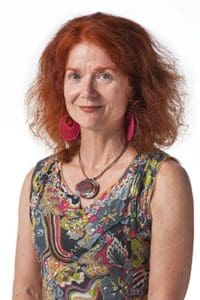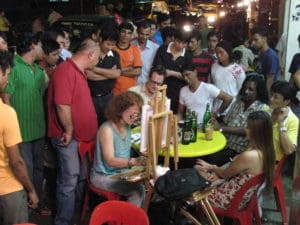Using Art To Transform Perceptions. Member Spotlight: Joan Marie Kelly
Joan Marie Kelly is an Irish American artist who has taught at Nanyang Technological University in Singapore since 2005. She has exhibited globally with solo exhibitions in New York, New Delhi and Morocco. Joan uses her artistic skills as a means to navigate interwoven community relations in Southeast Asia with her own status as foreigner, by engaging communities and other disciplines with elements of art making and art practice. In different contexts, art becomes a tool to engage with a new purpose.
Art as a Mediation
 Her introduction to Asia began in New York City when working as a waitress. The cooks in the kitchen were Indonesian, working under the table without proper visa’s. Not being able to return home, Kelly went home for them to deliver money, photographs and letters to their families. It was through the experience of living with Indonesian families that Kelly’s could see from new perspectives the myriad of social constructs that engulfed her own society in the United States, and it was here that her art making skills became a mediating force between herself and the new families. Kelly tells a story of living with a family of fourteen siblings. The oldest son would peer through an outside window at night to watch TV while with the rest of the family and Joan were inside watching comfortably from a couch. “I was distressed. As we sat together, his head would be behind us, but outside the window.”
Her introduction to Asia began in New York City when working as a waitress. The cooks in the kitchen were Indonesian, working under the table without proper visa’s. Not being able to return home, Kelly went home for them to deliver money, photographs and letters to their families. It was through the experience of living with Indonesian families that Kelly’s could see from new perspectives the myriad of social constructs that engulfed her own society in the United States, and it was here that her art making skills became a mediating force between herself and the new families. Kelly tells a story of living with a family of fourteen siblings. The oldest son would peer through an outside window at night to watch TV while with the rest of the family and Joan were inside watching comfortably from a couch. “I was distressed. As we sat together, his head would be behind us, but outside the window.”
At the time, a foreigner being in a home of a family that had very little income was extremely rare. Kelly was determined to change this situation somehow. This brother would press clothes standing at a hot iron all day fanning the coals inside. She persisted for about a month standing at his iron trying to engage him in conversation. Mixing Bahasa Indonesian with Sudanese languages, he began to laugh. Then when she offered to paint the portrait of his father, a prominent spiritual leader in the community. He began to take her to his local hangouts. Photography being very rare during his lifetime, the painted portrait opened a communication line to the family and community. A few years later the family, they notified her that the painting was used at the older man’s funeral. Through this experience, Joan demonstrated to herself that art practices were viable tools to forge connections.
Role Reversal
Kelly later began an art program at Keswick Multi-care Center, Baltimore, Maryland. Many people in the facility were idle sitting in wheelchairs. She wanted them to have an opportunity to tell their stories and began teaching them techniques of hand building with clay. Her philosophy was “anyone can participate no matter what your body is like. I’m your artistic tool. […] if the decision-making is yours, the piece is yours.” There was a homeless shelter nearby which housed many African-American children. Joan arranged to provide lunch for the children in exchange for their working one-on-one with the adults for an hour or two. In this way, Joan explains, the African American children were in the position of giving oversight and knew they were needed, as well as having an opportunity to create their own artwork.
Sustaining Endangered Languages
Along with her teaching responsibilities, Joan collaborates with practitioners around the world, including tourism ethnographer Yuthasak Chatkaewnapanon, Lecturer at Chiang Mai University, Thailand. Art practices are research tools to engage and gain understanding of local perspectives during rapid tourism development. This information is used to better equip the local persons to take control of the eminent transformation of their environments. Kelly also works with several linguists on the threat of language endangerment and extinction in a project called Visualizing Languages. Kelly mentors a group of student illustrators in collaboration with linguists and oral language speakers in Nagaland, India, in creating the first illustrated children’s books in once oral only languages. The linguist must work with communities for years learning the oral language. Then work with the community, to develop the first written grammar and dictionary of the once oral only language. The oral speakers lead this work, the community must accept the text if they are going to use it. The students work in steady contact with the oral speakers over WhatsApp to illustrate the traditional folktales by sending their sketches and asking questions about cultural interpretations. These are the first written texts of what was once an oral only language.
Teaching Art as a Process

Joan Marie Kelly painting portraits on the street in Singapore
Photo credit: Isabel Löfgren
Joan received her current job as the result of what she calls an “accident.” After seeing an announcement of the first art school in Singapore on the web, she took a look at the curriculum. For her, it was outrageous there were no drawing courses. She wrote an email to the university with her views. In response, the school suggested she apply to a newly open position. Joan describes the culture in Singapore as hierarchical, and there are approximately 300,000 male foreign workers in Singapore that are housed separately from society. Before the COVID-19 pandemic, Joan conducted her painting class in collaboration with these men, inside the hostels where the men live. In doing so she asks her students to interact with men from India and Bangladesh that the students have very set opinions of and see every day, but have never had a personal interaction.
“I try to put people in different situations using art as an encounter to transform their perceptions,” Joan says. “I don’t have a discussion beforehand. I ask the students to write their views anonymously.” “I want the student to figure it out through their personal experiences.” Joan teaches empathetic research methods in her classes, including digging deeper by asking open-ended questions and listening to stories. This approach was made broadly popular and is utilized in many different contexts by companies such as IDEO and Google; Tim Brown, Chair of IDEO, first coined the approach as “design thinking.” The idea is to approach design with empathy by understanding people’s daily lives, needs and motivations. The design of a product aligns with this discovery. Joan explains that this is an artistic process she has always carried out in creating her work, finding a new relationship between her visual art, her social artwork and contemporary technological design practices.
Article by Tess Hargarten, MBBI Writer
